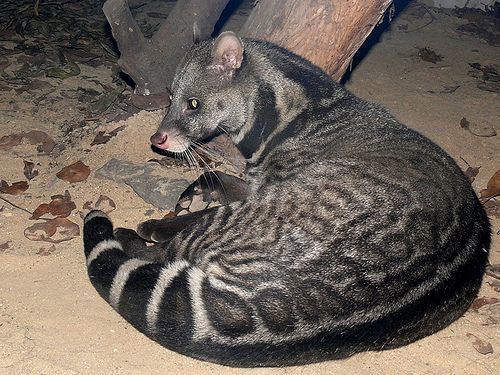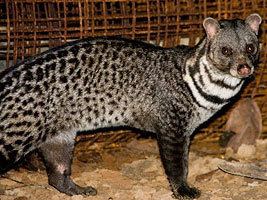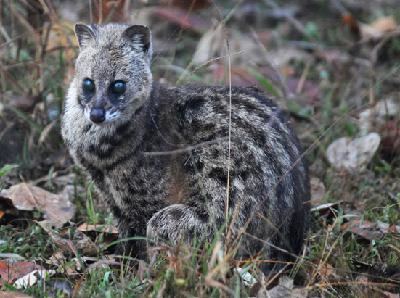Higher classification Viverra | Scientific name Viverra civettina | |
 | ||
Similar Large‑spotted civet, Brown palm civet, King genet, Abyssinian genet, Crested servaline genet | ||
The Malabar large-spotted civet (Viverra civettina), also known as the Malabar civet, is a viverrid endemic to the Western Ghats of India. It is listed as Critically Endangered by IUCN as its population size is estimated to number fewer than 250 mature individuals, with no subpopulation greater than 50 individuals. In the 1990s, isolated populations still survived in less disturbed areas of South Malabar but were seriously threatened by habitat destruction and hunting because they lived outside protected areas.
Contents

It is known as Kannan chandu and Male meru in Kerala, and in Karnataka as Mangala kutri, Bal kutri and Dodda punugina.
Characteristics

The Malabar large-spotted civet is dusky gray. It has a dark mark on the cheek, large transverse dark marks on the back and sides, and two obliquely transverse dark lines on the neck. These dark marks are more pronounced than in the large Indian civet. Its throat and neck are white. A mane starts between the shoulders. Its tail is ringed with dark bands. The feet are dark. It differs from the large-spotted civet by the greater nakedness of the soles of the feet. The hairs on the interdigital webs between the digital pads form submarginal patches; the skin of the plantar pad is naked in front and at the sides. There are remnants of the metatarsal pads on the hind foot as two naked spots, the external a little above the level of the hallux, the internal considerably higher. A male individual kept in the Zoological Gardens of Trivandrum in the 1930s measured 30 in (76 cm) in head and body with a 13 in (33 cm) long tail and weighed 14.5 lb (6.6 kg).
Distribution and habitat

In the 19th century, the Malabar civet occurred throughout the Malabar coast from the latitude of Honore to Cape Comorin. It inhabited the forests and richly wooded lowland, and were occasionally found on elevated forest tracts. It was considered abundant in Travancore.

Until the 1960s, extensive deforestation has reduced most of the natural forests in the entire stretch of the coastal Western Ghats. By the late 1960s, the Malabar civets was thought to be near extinction. In 1987, one individual was sighted in Kerala.
In 1987, two skins were obtained near Nilambur in northern Kerala, an area that is dominated by cashew and rubber plantations. Two more skins were found in this area in 1990. These plantations probably held most of the surviving population, as these were little disturbed and provided a dense understory of shrubs and grasses. Large-scale clearance for planting rubber trees threatened this habitat.
Interviews conducted in the early 1990s among local hunters indicated the presence of Malabar civet in protected areas of Karnataka. During camera traping surveys in lowland evergreen and semi-evergreen forests in the Western Ghats of Karnataka and Kerala from April 2006 to March 2007, no photographic record was obtained in a total of 1,084 camera trap nights.
Ecology and behavior
Malabar civets are considered nocturnal and so elusive that little is known about their biology and ecology apart from habitat use.
Threats
Until a few decades ago, Ayurvedic physicians in Kerala reared Malabar civets to obtain civetone, an extract from the scent gland, which was used in medicine, and as an aromatic.
It is now seriously threatened by habitat destruction and fragmentation. Until the 1990s, it was confined to remnant forests and disturbed thickets in cashew and rubber plantations in northern Kerala, where the hunting pressure was another major threat.
Taxonomic history
Reginald Innes Pocock considered V. megaspila and V. civettina to be distinct species. Ellerman and Morrison-Scott considered V. civettina a subspecies of V. megaspila.
